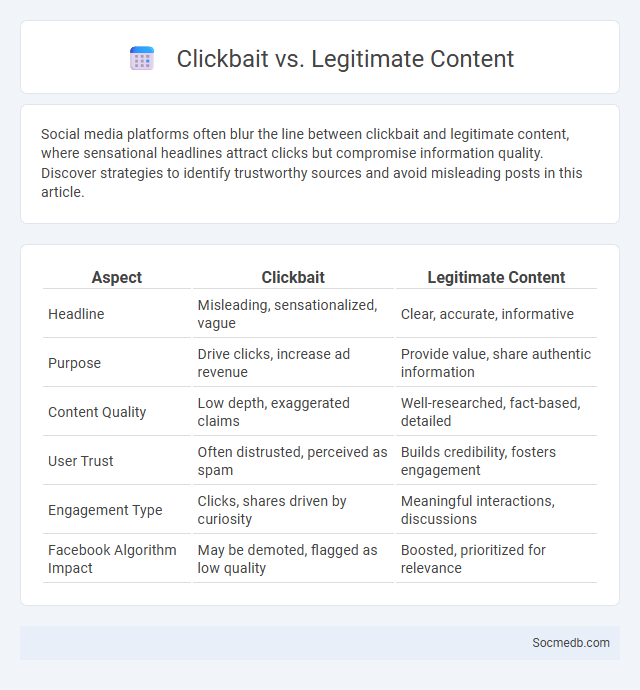
Photo illustration: Clickbait vs legitimate content
Social media platforms often blur the line between clickbait and legitimate content, where sensational headlines attract clicks but compromise information quality. Discover strategies to identify trustworthy sources and avoid misleading posts in this article.
Table of Comparison
| Aspect | Clickbait | Legitimate Content |
|---|---|---|
| Headline | Misleading, sensationalized, vague | Clear, accurate, informative |
| Purpose | Drive clicks, increase ad revenue | Provide value, share authentic information |
| Content Quality | Low depth, exaggerated claims | Well-researched, fact-based, detailed |
| User Trust | Often distrusted, perceived as spam | Builds credibility, fosters engagement |
| Engagement Type | Clicks, shares driven by curiosity | Meaningful interactions, discussions |
| Facebook Algorithm Impact | May be demoted, flagged as low quality | Boosted, prioritized for relevance |
Understanding Clickbait: Definition and Characteristics
Clickbait is a type of content designed to attract attention and encourage users to click on a link, often by using sensationalized headlines or misleading information. Key characteristics include exaggerated claims, curiosity gaps, and emotionally charged language aimed at driving high engagement and maximizing ad revenue. Understanding these tactics helps users critically evaluate content authenticity on platforms like Facebook, Twitter, and Instagram.
What Constitutes Legitimate Content?
Legitimate content on social media is defined by authenticity, compliance with platform guidelines, and adherence to legal standards such as intellectual property rights and privacy laws. It includes original posts free from misinformation, hate speech, or harmful content, ensuring respectful and truthful communication. Platforms use algorithms and human moderation to enforce these policies, promoting a safe and credible online environment.
Clickbait vs Legitimate Content: Key Differences
Clickbait content relies on sensational headlines and exaggerated claims to attract clicks, often leading to misleading or shallow information that can harm Your trust and online experience. Legitimate content provides accurate, well-researched, and valuable information that fosters credibility and meaningful engagement with the audience. Understanding the key differences helps You discern reliable sources and avoid falling victim to deceptive marketing tactics on social media platforms.
The Psychology Behind Clickbait Tactics
Clickbait tactics exploit psychological triggers such as curiosity gap, fear of missing out (FOMO), and emotional arousal to drive higher engagement on social media platforms. These strategies rely on viewers' innate desire for quick information and reward anticipation, often leading to increased click-through rates but reduced content satisfaction. Understanding the cognitive biases behind clickbait helps marketers create compelling headlines while users develop critical media literacy skills.
Impact of Clickbait on Audience Trust
Clickbait often manipulates curiosity with misleading headlines, eroding audience trust in social media content. When Your expectations are repeatedly unmet due to exaggerated or false claims, skepticism grows, leading to reduced engagement and loyalty. Restoring trust requires honest, transparent communication that respects the audience's intelligence and fosters authentic connections.
SEO Implications: Clickbait vs Legitimate Content
Clickbait headlines can temporarily boost your social media engagement but often harm SEO rankings due to high bounce rates and diminished user trust. Legitimate content with well-researched keywords and valuable information enhances your website's authority and improves organic search visibility. Your strategy should prioritize authentic, relevant posts that foster long-term audience retention and positive search engine signals.
How to Identify Clickbait in the Wild
Clickbait often features sensational headlines designed to provoke curiosity without delivering substantial content, such as exaggerated claims or ambiguous phrases like "You won't believe what happened next." Recognize these by analyzing the headline's specificity and verifying the credibility of the source before engaging. Protect your information by avoiding links with misleading titles and prioritizing content from trusted social media accounts.
Strategies for Creating Compelling Yet Honest Headlines
Crafting compelling yet honest social media headlines requires balancing attention-grabbing language with transparency to build trust and drive engagement. Your headlines should clearly reflect the content's value, using relevant keywords and emotion-driven words to attract clicks without misleading your audience. Prioritize authenticity by avoiding clickbait tactics, ensuring that your message aligns with your brand's voice and audience expectations.
The Ethics of Clickbait in Digital Publishing
Clickbait tactics exploit sensational headlines to drive clicks but often compromise content quality and trustworthiness in digital publishing. Maintaining ethical standards requires balancing engaging titles with accurate, valuable information to protect Your audience's trust and long-term loyalty. Transparent and responsible content promotes sustainable growth and upholds the integrity of social media platforms.
Future Trends: Will Clickbait or Legitimate Content Prevail?
The future of social media hinges on the balance between clickbait and legitimate content, with algorithms increasingly prioritizing user engagement quality over sheer volume. Emerging AI technologies enhance content verification, helping platforms reduce misinformation and promote credible sources. Your ability to discern authentic content amidst sensationalism will shape how social media evolves toward fostering trust and meaningful interactions.
 socmedb.com
socmedb.com